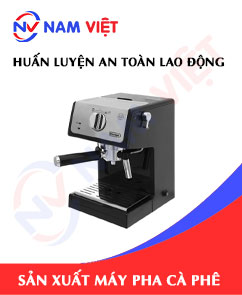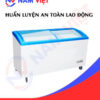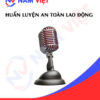Occupational Safety Training in Coffee Machine Manufacturing
99,000 ₫
Note: The above price is calculated for one person, the price may fluctuate depending on the number of trainees participating in the course and depending on market movements. For more accurate pricing support, please refer to the quotation table or contact our consulting staff directly.
Occupational safety is an important issue in coffee machine manufacturing factories and needs to be addressed promptly to ensure the health and safety of workers, and to enhance the reputation of businesses. The Occupational safety training course is one of the effective solutions to raise awareness about accident prevention for workers participating in coffee machine manufacturing.
Table of Contents
Toggle1. Overview of Coffee Machines
a. What is a Coffee Machine?
A coffee machine (Coffee maker) is a versatile device used to brew coffee by heating water and adding ground coffee or coffee pods to produce the beverage. Modern coffee machines come with various functions and designs, including automatic coffee machines, semi-automatic coffee machines, espresso machines, drip coffee makers, manual coffee machines, and many other types.

b. Main Components of a Coffee Machine
The main components of a coffee machine include:
- Automatic coffee grinder: responsible for grinding coffee and brewing it automatically. This type of machine is commonly used in large cafes and restaurants.
- Coffee filter: a critical part of the coffee-making process. Coffee filters come in various sizes to match the coffee machine and type of coffee used.
- Coffee tamper: a device used to grind coffee into fine powder. Coffee tampers are usually equipped with powerful motors to grind large quantities efficiently.
- Water pump: a device used to pump water through the coffee filter to produce coffee. The water pump must be strong enough to pass water through the filter and create sufficient pressure for extraction.
- Valve system: an important device for controlling the water flow through the coffee filter and maintaining proper pressure.
- Control unit: the main part of the coffee machine that controls other components and executes different functions of the machine.
- Water reservoir: a tank used to hold clean water for coffee brewing.
c. Coffee Machine Manufacturers in Vietnam
Below are some well-known coffee machine brands worldwide:
- Breville: an Australian brand specializing in coffee and cooking products, including coffee machines, coffee grinders, coffee roasters, and more.
- De’Longhi: an Italian brand famous for coffee machines, coffee grinders, coffee roasters, espresso machines, and other household appliances.
- Keurig: an American brand specializing in automatic coffee machines with pre-packaged coffee pods.
- Nespresso: a Swiss brand known for espresso machines and pre-packaged coffee capsules.
- Jura: a Swiss brand specializing in high-end espresso machines and automatic coffee machines.
- Philips: a Dutch brand producing household appliances, including coffee machines.
- Saeco: an Italian brand producing automatic coffee machines and related household coffee products.
- Siemens: a German brand producing household appliances, including coffee machines.
- Gaggia: an Italian brand producing espresso machines and other household appliances.
- La Marzocco: an Italian brand producing professional coffee machines for cafes and restaurants.

d. Specific Jobs in a Coffee Machine Manufacturing Plant
Group 1
- CEO, Deputy CEO, department heads in the coffee machine manufacturing plant.
Group 2
- Safety officers: manage safety in the factory, design safety procedures, supervise and ensure employees comply with safe working protocols.
Group 3
- Procurement and materials management: purchasing specialists plan and find reputable suppliers to provide parts and materials necessary for coffee machine production.
- Production and assembly: technicians manufacture necessary components for the coffee machine, including electronic devices, pumps, and pipes, then assemble them into complete products.
- Quality control: the factory inspects each product using testing equipment and measures machine accuracy.
- Packing and shipping: after quality checks, coffee machines are packed and shipped to dealers and customers worldwide.
- Maintenance and repair: the factory also provides maintenance and repair services to ensure the reliability and performance of coffee machines during customer use.
Group 4
- Office work, service, sales, marketing.
- Production management, quality management, human resources, material management, financial and accounting management.
- Product design and research: the research team generates new ideas, studies market demand, and develops new products.

2. Overview of Occupational Safety Training for Coffee Machine Production
In this article, we focus on issues related to Group 3, as they are directly involved in production and face the highest occupational safety risks. Refer to other groups here.
a. What is Group 3 Occupational Safety Training?
- Group 3 occupational safety training consists of sessions that equip workers with knowledge and awareness of how to prevent workplace accidents.
- The training helps workers recognize hazards and avoid risks, reducing the likelihood of accidents while working.
REGISTER FOR OCCUPATIONAL SAFETY TRAINING SERVICE
b. Training Duration
Initial Occupational Safety Training
- Total training time is at least 24 hours, including testing time.
- 8 hours of theoretical lessons on policies, laws regarding occupational safety and hygiene
- 8 hours of theoretical lessons on basic knowledge of occupational safety and hygiene
- 4 hours of theoretical lessons on specialized training content
- 2 hours of practical training on specialized content
- 2 hours of final theoretical exam
The training center arranges the schedule into multiple sessions depending on workers’ availability. Typically, there are 6 sessions over 3 days if the production company can allocate continuous training time.
Periodic Occupational Safety Training
- Before the occupational safety card expires, workers wishing to renew it must undergo periodic occupational safety training, with a minimum training duration of at least 50% of the initial training time.
Explanation: total periodic occupational safety training time is at least 12 hours, including testing. After completing the periodic training and passing the test, workers will be reissued or have their occupational safety card extended.
c. Training Content
| No. | TRAINING CONTENT | TRAINING DURATION (HOURS) | |||
| Total | Including | ||||
| Theory | Practice | Exam | |||
| I | Policies and Laws on Occupational Safety and Hygiene | 8 | 8 | 0 | 0 |
| 1 | Overview of the system of legal documents on occupational safety and hygiene. | 6 | 6 | ||
| 2 | Standards and technical regulations on occupational safety and hygiene. | 1 | 1 | ||
| 3 | Specific regulations from government authorities on occupational safety and hygiene for new construction, expansion, or renovation of facilities, production, usage, storage, and inspection of machinery, equipment, materials, and substances with strict safety requirements. | 1 | 1 | ||
| II | Basic Knowledge of Occupational Safety and Hygiene | 8 | 8 | 0 | 0 |
| 1 | Basic knowledge of hazards and harmful factors in the workplace. | 4 | 4 | ||
| 2 | Methods to improve working conditions. | 1 | 1 | ||
| 3 | Safety culture in production and business. | 1 | 1 | ||
| 4 | Rights and responsibilities of employers and employees; policies and regulations on occupational safety and hygiene for employees; roles and duties of safety networks and safety officers. | 1 | 1 | ||
| 5 | Safety rules, signage, safety instructions, use of safety equipment and personal protective equipment; skills in first aid for workplace accidents, and prevention of occupational diseases. | 1 | 1 | ||
| III | Specialized Training Content | 6 | 4 | 2 | 0 |
| Comprehensive knowledge of machinery, equipment, substances generating hazardous factors; analysis, evaluation, risk management for occupational safety and hygiene; safe working procedures for machinery, equipment, and substances with strict safety requirements. | 6 | 4 | 2 | ||
| IV | Final Safety Training Exam | 2 | 2 | 0 | 0 |
| Total | 24 | 22 | 2 | ||
See more training content of the 6 groups
d. Occupational Safety Card
After completing the occupational safety training and passing the exam, workers will be issued an Occupational Safety Card (commonly referred to as Group 3 Occupational Safety Certificate).
The Group 3 safety card clearly displays the worker’s name, date of birth, specific job and working environment, training duration, red stamp, and signature confirming the completion of training.
According to Clause 2 of Article 24, Decree 44/2016/ND-CP, there are 2 cases:
- If the employer and employee have a labor contract, the employer must sign, stamp, and validate the safety card for Group 3 trainees after they complete the training from an occupational safety training provider and pass the test.
- If the worker is freelance, seasonal, or does not have a labor contract, the training unit must sign, stamp, and validate the safety card after the worker completes the training and passes the exam.

3. Identifying Hazards Affecting Workers in Coffee Machine Production
During the coffee machine production process, workers may encounter various potential hazards, including:
- Risk of electric shock: During production, workers will come into contact with electrical components, wires, circuit boards, and other electronic parts, so caution is needed to avoid electric shock.
- Risk of fire and explosion: During production, workers use mechanical devices, electrical equipment, and chemicals to assemble coffee machines. Therefore, fire and explosion safety must be ensured to prevent accidents.
- Risk of poisoning: During production, workers may come into contact with toxic chemicals, dyes, solvents, and adhesives, so protective equipment should be worn, and work should be performed in a health-safe environment.
- Risk of impact: During assembly, moving, and transporting coffee machines, workers may face the risk of collisions, scratches, or injuries.
- Risk of slips and falls: During moving and assembling coffee machines, workers may face risks of tripping over materials, equipment, and production tools.
- Risk of noise exposure: During production, workers may be exposed to high noise levels from machines and equipment, affecting hearing and overall health.
4. Common Occupational Accidents for Workers in Coffee Machine Production
Common occupational accidents for workers in coffee machine production may include:
- Injuries to wrists, forearms, hands, and fingers: Occur when working with coffee machine components, especially during assembly.
- Burns from heat: Occur when contacting hot coffee brewing parts, coffee machines, and other brewing equipment.
- Back injuries: Occur due to heavy lifting when moving heavy equipment or working in improper postures.
- Eye injuries: Occur when using tools and equipment incorrectly or without protective glasses.
- Head and facial injuries: Occur when using tools and equipment incorrectly.
- Hearing loss: Caused by noise from production equipment, including coffee machines, affecting workers’ hearing.
- Collisions and falls: Occur when moving and using equipment in confined spaces or using equipment improperly.

5. Safety Measures for Participating in Coffee Machine Production
Safety measures for participating in coffee machine production include:
- Ensure occupational safety regulations: Staff participating in coffee machine production should be trained on occupational safety regulations and provided with personal protective equipment such as masks, safety glasses, gloves, protective jackets, safety shoes, etc.
- Use protective devices: Coffee machine production machines should be equipped with protective devices to ensure workers’ safety, such as safety sensors, emergency stop machines, etc.
- Inspect and maintain equipment: Coffee machine production machines should be regularly inspected to ensure they operate efficiently and safely. Damaged or worn parts must be replaced promptly.
- Ensure cleanliness and hygiene: Coffee machine production factories must maintain cleanliness and hygiene, especially during production and assembly. The use of cleaning chemicals must be done correctly and safely for workers.
- Ensure safe transportation and storage: Produced coffee machines must be transported and stored properly to ensure safety for workers and users. Transportation and storage regulations must be strictly followed.
- Occupational safety training: Staff participating in coffee machine production must be trained on safety procedures and the use of protective equipment. Safety regulations should be clearly explained to ensure employees understand and follow occupational safety procedures.
- Periodically conduct workplace environment monitoring in factories, collect and analyze harmful factors for workers, then adjust to reduce hazards to prevent occupational diseases.
6. Benefits of Occupational Safety Training in Coffee Machine Production
An Toan Nam Viet provides your business with the following benefits upon completing occupational safety training courses according to Decree 44/2016/ND-CP on occupational safety and hygiene:
- Workers can identify potential occupational hazards and take preventive measures to avoid accidents.
- Your business can establish risk prevention measures in production, operation, and maintenance processes.
- Minimize costs associated with safety risks in labor.
- Continuous production helps increase labor productivity and product quality.
- Compliance with occupational safety laws, avoiding legal risks.
- Build reputation and professionalism in all aspects, thereby enhancing your business brand.
Nam Viet training courses provide solutions to prevent external hazards from affecting individuals, helping them avoid dangers that could lead to injuries or, in severe cases, death.
REGISTER FOR OCCUPATIONAL SAFETY TRAINING SERVICE
7. Customer Feedback after Completing Coffee Machine Production Safety Training
An Toan Nam Viet has many years of experience accompanying numerous businesses in Vietnam in general and southern provinces in particular. This responsibility is highly valuable to Nam Viet, which is why our Occupational Safety Training is increasingly professional. Our growth and development are driven by positive feedback and suggestions from our business partners. Below are the feedbacks from partners we have served.
Bac Nam E&C Investment and Construction Joint Stock Company
“The first time using An Toan Nam Viet’s service, I was surprised by the 24/7 support of the consulting team. The class organization was very quick and convenient for our company. Thank you very much for Nam Viet’s service!”
Hoa Dat Construction and Trading Joint Stock Company
“Nam Viet’s service has helped us greatly in simplifying occupational safety and completing safety documentation for the working process. The consulting team responds promptly and enthusiastically to our inquiries. 5 stars for Nam Viet.”
See more customer interview sessions after using the service of An Toan Nam Viet
8. An Toan Nam Viet’s Occupational Safety Training Capability
An Toan Nam Viet is a reputable and quality occupational safety training center in Vietnam. Safety training sessions are continuously conducted at production workshops, factories, or construction sites nationwide (63 provinces in Vietnam).
REGISTER FOR OCCUPATIONAL SAFETY TRAINING SERVICE
Occupational Safety Training License
- An Toan Nam Viet has been inspected and certified by the Department of Safety under the Ministry of Labor – Invalids and Social Affairs, granting a certificate of eligibility for occupational safety and hygiene training. This further reinforces our occupational safety training capabilities.

Materials and Lectures
- Before occupational safety training materials are included in the safety training courses, they are reviewed and approved to ensure knowledge accuracy and effectiveness.
- Teaching methods of instructors are standardized according to An Toan Nam Viet standards, derived from expert research in occupational safety and hygiene training to maximize knowledge absorption.
Facilities
- Controlling classroom factors affecting training improves teaching efficiency and learners’ knowledge absorption.
- Training support facilities include spacious classrooms meeting standards for area, lighting, training equipment, etc.
9. Nationwide Reputable Occupational Safety Training Center
At An Toan Nam Viet, we prioritize occupational safety training with dedication. We aim to equip workers with knowledge to protect themselves, contributing to the nation’s development.
To ensure effective training, we meticulously prepare every detail, from teaching tools and equipment to curricula, materials, sound, and lighting.
Our safety training instructors are experts with many years of experience, including research on hazard identification and prevention across industries.
Lectures are practical and delivered in an engaging, easy-to-understand manner for workers. The content strictly follows Decree 44/2016/ND-CP.
Thus, workers learn preventive measures and how to protect themselves, applying them appropriately in real work.
Our training center proudly provides professional and reputable occupational safety training services with the following advantages:
- Competitive training costs with assured quality.
- Flexible training schedule suitable for company production.
- Fast and legal certification procedures for occupational safety training.
- Experienced instructors with many years in the field.
- Controlled classroom factors improve teaching efficiency and knowledge absorption.
- Lectures tailored to occupational safety in enterprises.
- Dedicated and professional support for customers quickly and accurately.

10. Additional References for Coffee Machine Production Safety Training Materials
- Occupational Safety Materials for Coffee Machine Production
- Occupational Safety Training Materials Set
- Occupational Safety Training Test Set
- Occupational Safety Training Curriculum for Coffee Machine Production
- Coffee Machine Production Occupational Safety Quiz
1 review for Occupational Safety Training in Coffee Machine Manufacturing
No comments yet















namchinh.haiphong341
Đơn vị an toàn lao động uy tín tại Việt Nam nhé!